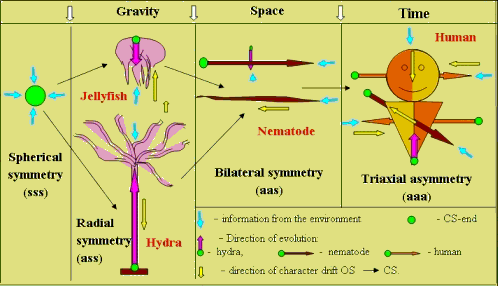|
Evolutionary
Theories of Asymmetrization of Organisms, Brain and Body (I)
 “We know far
too little about the adaptive importance of directional
asymmetry”
“We know far
too little about the adaptive importance of directional
asymmetry”
R. Palmer (2004)
What is the biological role of left-handedness and it's
evolutionary importance ?
What is the fundamental difference between left- and
right-handed individuals?
How handedness is related with brain asymmetry and sex?
Features of the
symmetry are determined by the isotropy of the environment.
Maximal extent of organism symmetry corresponds to a
completely isotropic ecological niche.
First organisms
on Earth floating in the depths of water unicellular
and lower multicellular organisms had the maximum possible
spherical symmetry. They appeared approximately 3.5
billon years ago. Anisotropic environment step by step was
leading to asymmetry of the organisms.
Asymmetrization
along the “top – bottom” axis occurred under the influence
of gravity. This led to the appearance of the
attached, low-mobile forms (plants and coelenterates) that
had radial symmetry.
Asymmetrization
along the “front – back” axis occurred due to the
interaction with space, when rapid motion was
required (to escape from the predator, or to chase a pray).
As a result, the main receptors and the brain were moved to
the front of the body. Organisms with bilateral
symmetry were dominating last 650-800 million years.
These are
crustaceans, fish
as well as the most progressive forms, i.e., mammals, birds,
and insects.
V. Beklemishev
(1964) distinguished three types of symmetry (spherical,
radial, and bilateral) and arranged them in evolutionary
array (Fig. 1). Forth type of triaxial asymmetry (aaa)
he mistakenly assigned to a primitive organism (amoeba) and
placed at the beginning of the array.
Organisms of bilateral symmetry were considered the “crown”
of evolution.
| Amoeba
→ spherical
→ radial
→
bilateral symmetry |
|
 |
Fig. 1. The evolutionary array of organisms’ symmetry types.
c — symmetry,
а
— asymmetry of an organism on
each of the 3 axis of the three-dimensional space.
What determines
asymmetry along the “left – right” axis
was unknown.
Basic statements of the new theory:
1. The evolution of any structure goes from
symmetry
to asymmetry.
The asymmetry of the organisms in the Phylogeny grows on
all three axes (I — dorso-ventral (back – belly), II —
anterior-posterior (nose – tail), III — and mediolateral
(left – right).
2.
Symmetry
and asymmetry are features of a shape. Amoeba is
shapeless and therefore should be removed from the
evolutionary array.
Extrapolation of evolutionary logic of the existing array:
ccc
®
аcc
®
ааc have allowed to state a hypothesis about further
asymmetrization
of modern progressive forms and their natural transition
from
bilateral
symmetry to the last type—triaxial
asymmetry
(TA)
(аас
®
ааа).
Growing number of the facts of
lateral asymmetry found in
modern progressive forms
(functional asymmetry of a brain,
right handedness in humans,
unilateral ovulation and
unihemispheric sleep of dolphins)
confirms this transition.
3. Which
factor of the
environment dictates the development of lateral
asymmetry?
According to the idea of asynchronous evolution such factor
can be time,
so one side (organ) is more advanced ("vanguard" as, already
in the future) and another one is a "rear-guard" (as yet in
the past).
Triaxial
asymmetry type should be the most evolutionary advanced
(Fig.
3).

Fig. 3.
Adaptive asymmetrization of organisms in anisotropic
environment
4. So,
the information flows from
the
isotropic
environment create
asymmetry
in organisms. How the field acts upon the organism and why
it evolves? Let’s take one-dimensional (linear) organism —
hydra in the field of gravity and earthworm (or
snake) in space.
Phenotype appears from interrelation of genetic and
environment information: P = G + E. The source of genetic
information is zygote. Since the organism is developed from
the zygote, in hydra it should be located at the bottom of
the foot, and information flow should move to the top
towards
tentacles
and at earthworm zygote at
 the
end of the tail and genetic information flows to the nose,
so
tentacles
are younger than the leg and nose — younger than the tail.
Can development start from the nose? No, because ontogeny
repeats phylogeny. Can it start in the middle of linear
organism? Yes, if development starts at the border of two
environments (ground – atmosphere as in the case of plants,
then seed is growing up and down). Information from the
environment always go towards (growth) and forms the
gradient of potential. Then the new organ (character) should
appear at the point of growth. If they are necessary
their, like receptors or brain, they stay others drift along
the gradient towards the tail. The Evolutionary Theory of
Sex allows verifying this hypothesis. Hydra had all three
types of reproduction: asexual (using kidneys),
hermaphrodite, and dioecious, and earthworm had asexual and
hermaphrodite. Theory of Sex predicts that ovaries at hydra
should be between kidneys and testes, and at earthworm —
closer to the tail than testes. That is so. Hydra has
kidneys at the bottom, ovaries higher and testes even
higher. Ovaries of earthworm are in the 13th
segment and testes — only in the 10th. the
end of the tail and genetic information flows to the nose,
so
tentacles
are younger than the leg and nose — younger than the tail.
Can development start from the nose? No, because ontogeny
repeats phylogeny. Can it start in the middle of linear
organism? Yes, if development starts at the border of two
environments (ground – atmosphere as in the case of plants,
then seed is growing up and down). Information from the
environment always go towards (growth) and forms the
gradient of potential. Then the new organ (character) should
appear at the point of growth. If they are necessary
their, like receptors or brain, they stay others drift along
the gradient towards the tail. The Evolutionary Theory of
Sex allows verifying this hypothesis. Hydra had all three
types of reproduction: asexual (using kidneys),
hermaphrodite, and dioecious, and earthworm had asexual and
hermaphrodite. Theory of Sex predicts that ovaries at hydra
should be between kidneys and testes, and at earthworm —
closer to the tail than testes. That is so. Hydra has
kidneys at the bottom, ovaries higher and testes even
higher. Ovaries of earthworm are in the 13th
segment and testes — only in the 10th.
5.
Organisms
of triaxial asymmetry keep two previous asymmetries.
Lateral asymmetry appears on a background of previous
ones (a ‘back–belly’ from a jellyfish, and ‘nose-tail’ from
the opossum), therefore it should spread from front to back.
6. Increase
in asymmetry
can be seen in evolution of many systems:
-
The trend towards asymmetry can be followed in
phylogeny of plant organs (flower, leaf, fruits,
and
seeds). It is known, that zygomorphic (bilateral
symmetry) flowers [Gladiolus sp., Orchids, Eyebrights
and Violets] are evolutionary more progressive, than actinomorphic (radial symmetry) flowers [Primula,
Narcissus, Pyrola], but are less progressive, than
triaxial asymmetric ones [Cannaceae and Valerianaceae].
-
The morphology of a leaf
during evolution follows the same picture:
spherical
symmetry of
chlorella,
radial
symmetry of
pine needles,
bilateral
symmetry
of Magnolia leafs, and
triaxial
asymmetry
of Begonia or
Elms
leafs.
-
The same trend can be found in embryogenesis—spherical
zygote, radial gastrula, bilateral embryo and triaxial
asymmetric child.
Vertebrate embryos (and indeed, many invertebrates)
exhibit a strikingly conserved left-right
asymmetry of the internal organs. Nearly all
visceral organs of the thorax and abdomen are
left-right asymmetrical in their anatomy, placement,
and, in some cases, physiology. Directional
left-right asymmetry is conserved throughout
chordate evolution, although the details of anatomical
asymmetry can vary among species.
One can conclude that asymmetrization is not
especially human phenomenon, but general evolutionary
phenomenon inherent to all live systems.
Brain Asymmetry
(II)
►
Asymmetry of paired organs, hands
(III) ►
Questions
Predictions
References
Evolutionary role of asymmetrization of organisms, brain and body (Model and
Right-hand rule).
Geodakyan V.
A. 20th
Congress
of the I.P. Pavlov Physiological society. Symposium: "Functional
interhemisphere asymmetry”. Thesis of presentations. June 4-8, 2007, Moscow.
p. 28.
|